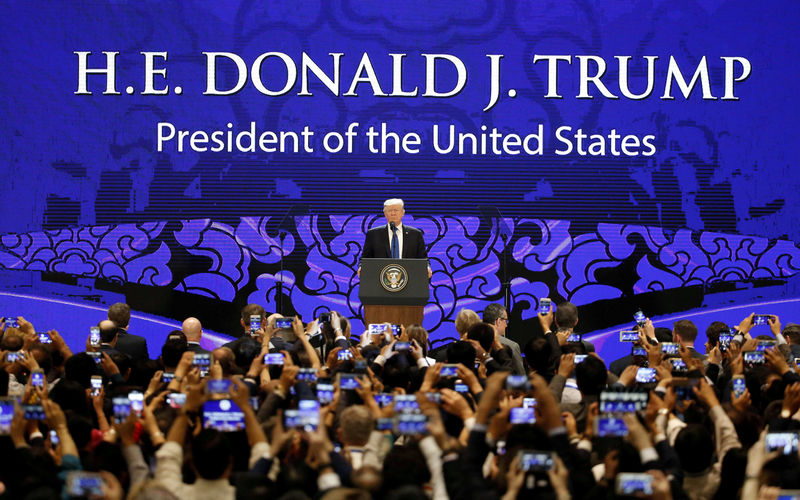 © Reuters. U.S. President Donald Trump speaks on the final day of the APEC CEO Summit ahead of the Asia-Pacific Economic Cooperation (APEC) leaders summit in Danang
© Reuters. U.S. President Donald Trump speaks on the final day of the APEC CEO Summit ahead of the Asia-Pacific Economic Cooperation (APEC) leaders summit in DanangBy Kiyoshi Takenaka and Matthew Tostevin
DANANG, Vietnam (Reuters) – Countries in the Trans Pacific Partnership (TPP) have agreed on steps to move ahead with the trade deal despite resistance from Canada at talks in Vietnam that had put new doubts over its survival, officials said.
According to a draft of the final statement seen by Reuters and due to be released on Saturday, the 11 countries have agreed to the core elements of a deal but more work remains.
Moving ahead with TPP would be a boost for the principle of multilateral trade agreements after U.S. President Donald Trump ditched it this year in favor of an “America First” policy that he reiterated at an Asia-Pacific summit in Vietnam.
The draft said ministers had agreed the core elements of what they described as the Comprehensive and Progressive Agreement for Trans-Pacific Partnership (CPTPP). It said a “limited set of provisions” from the original deal would be suspended.
It also said further technical work was needed on areas that still needed consensus “to prepare finalised text for signature”. It did not say when that might happen.
A Canadian official said: “We’ve agreed to a framework towards the deal with work programs to deal with issues.”
Talks fell into disarray on Friday when Japan’s President Shinzo Abe canceled a meeting of leaders from the TPP countries after Canadian Prime Minister Justin Trudeau did not arrive there.
Canadian Trade Minister Francois-Philippe Champagne later blamed “a misunderstanding about the schedule” for Trudeau’s absence, but said more work was needed to take TPP forward – specifically mentioning the auto sector and cultural protection.
JAPANESE LOBBYING
Partly to counter China’s growing dominance in Asia, Japan had been lobbying hard for the TPP pact, which aims to eliminate tariffs on industrial and farm products across an11-nation bloc whose trade totalled $356 billion last year.
Japanese Economy Minister Toshimitsu Motegi said late on Friday that all 11 countries had now agreed on the plan to move ahead.
Canada, which has the second biggest economy among remaining TPP countries after Japan, had said it wanted to ensure an agreement that would protect jobs and was in no hurry.
As well as the cuts to tariffs, the TPP agreement has provisions for protecting the environment, workers’ rights and intellectual property – one of the major sticking points after the departure of the United States.
Canada’s position has been further complicated by the fact that it is simultaneously renegotiating the North American Free Trade Agreement (NAFTA) with the Trump administration.
At a speech in Danang, Trump set out a strong message on trade in which he made clear he was only interested in bilateral deals in Asia which would never put the United States at a disadvantage.
China’s President Xi Jinping, meanwhile, used the same forum to stress multilateralism and said that globalization is an irreversible trend.
APEC, whose leaders hold their full summit on Saturday, has itself been buffeted by the changes under Trump.
Talks between trade and foreign ministers from the group failed to reach agreement on their usual joint statement in the face of U.S. demands to remove language about supporting free trade and fighting protectionism.
Fusion Media or anyone involved with Fusion Media will not accept any liability for loss or damage as a result of reliance on the information including data, quotes, charts and buy/sell signals contained within this website. Please be fully informed regarding the risks and costs associated with trading the financial markets, it is one of the riskiest investment forms possible.
Source: Investing.com



























